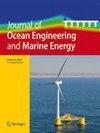船舶机舱设计过程中维修费用估算的预测工具
IF 2.8
Q4 ENERGY & FUELS
引用次数: 1
摘要
摘要在船舶机舱维修中,机械和系统周围的可用空间(间隙)起着重要的作用,对维修干预的成本有很大的影响。在当前研究Gualeni等人(船舶技术研究,10.1080/ 09377255.2021.2020949,2022)的第一部分中,使用通用线性模型(GLM)的贝叶斯方法,参考大型系统Sánchez-Herguedas等人的单个项目/组件,确定了由于间隙减少而导致的维护成本增量之间的定量关系(可靠性工程系统Saf 207: 107394, 2021)。本文代表了该活动的第二部分,它对整个机器或系统进行了系统的观察(Sanders和Klein, Proc computer Sci 8:413 - 419,2012)。其目的不仅是确定维护成本和间隙减少之间的关系,而且确定单个部件/项目的间隙减少如何相互作用并影响整个系统/机械的可及性和可维护性,即相关的新特性。Salvatier et al. (Peer J computer Sci 2: e55, 2016);即,系统由状态不可观测的马尔可夫过程建模。状态的顺序是系统的可维护性(它包含了单个组件中的每一个),而证据是与空间减少相关的维护成本的增加。通过预测一系列状态,可以预测系统组件间隙之间的相互作用,并确定正在出现的可维护性如何受到机舱设计的影响。本文章由计算机程序翻译,如有差异,请以英文原文为准。
A prediction tool for maintenance costs estimation during the design process of a ship engine room
Abstract When dealing with maintenance in ships engine room, the space available around machinery and systems (clearance) plays an important role and may significantly affect the cost of the maintenance intervention. In a first part of a current research study Gualeni et al. (Ship Technol Res, 10.1080/09377255.2021.2020949, 2022), a quantitative relation between the maintenance costs increment due to the clearance reduction is determined, using a Bayesian approach to General Linear Model (GLM), with reference to a single item/component of a larger system Sánchez-Herguedas et al. (Reliability Eng Syst Saf 207: 107394, 2021). This paper represents the second part of the activity and it enforces a systemic view over the whole machinery or system Sanders and Klein (Proc Comput Sci 8:413–419, 2012). The aim is to identify not only the relation between maintenance costs and clearance reduction, but also how the clearance reductions of the single components/items interact and affect the whole system/machinery accessibility and maintainability, meant as relevant emerging properties. The system emerging properties are investigated through the design and application of a Hidden Markov Model Salvatier et al. (Peer J Comput Sci 2: e55, 2016); i.e., the system is modeled by a Markov process with unobservable states. The sequence of states is the maintainability of the system (which incorporates each one of the single components) while the evidence is the increase in cost of maintenance related to the space reduction. By predicting a sequence of states, it is therefore possible to predict the interactions between the system components clearances and determine how the emerging maintainability property is affected by the engine room design.
求助全文
通过发布文献求助,成功后即可免费获取论文全文。
去求助
来源期刊

Journal of Ocean Engineering and Marine Energy
Engineering-Ocean Engineering
CiteScore
3.80
自引率
5.30%
发文量
47
期刊介绍:
The Journal of Ocean Engineering and Marine Energy publishes original articles on research and development spanning all areas of ocean engineering and marine energy. The journal is designed to advance scientific knowledge and to foster innovative engineering solutions in the following main fields: coastal engineering, offshore engineering, marine renewable energy, and climate change and the resulting sea-level rise. Topics include, but are not limited to: Offshore wind energy technologyWave and tidal energyOcean thermal energy conversionOceanographical engineeringStructural mechanicsHydrodynamicsLinear and nonlinear wave mechanicsNumerical analysisMarine miningPipelines and risersComputational fluid dynamicsVortex-induced vibrationsArctic engineeringFluid-structure interactionUnderwater technologyFoundation engineeringAquacultural engineeringInstrumentation, full-scale measurements and ocean observational systemsModel testsHydroelasticityOcean acousticsGlobal warming and sea level riseOcean space utilizationWater qualityCoastal engineeringPhysical oceanographyThe journal also welcomes occasional review articles by leading authorities as well as original works on other emerging and interdisciplinary areas encompassing engineering in the ocean environment.
 求助内容:
求助内容: 应助结果提醒方式:
应助结果提醒方式:


